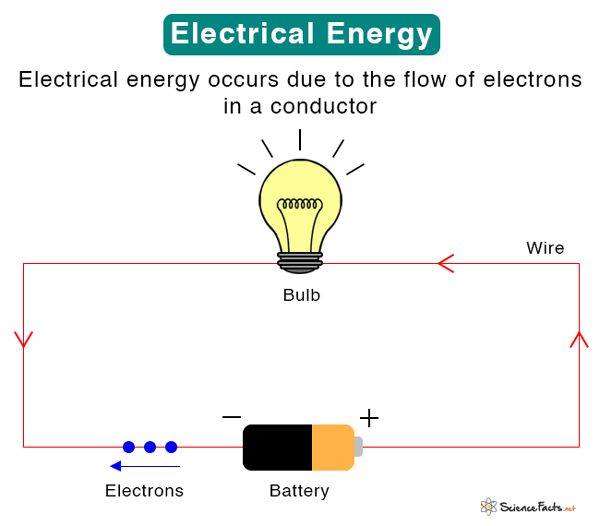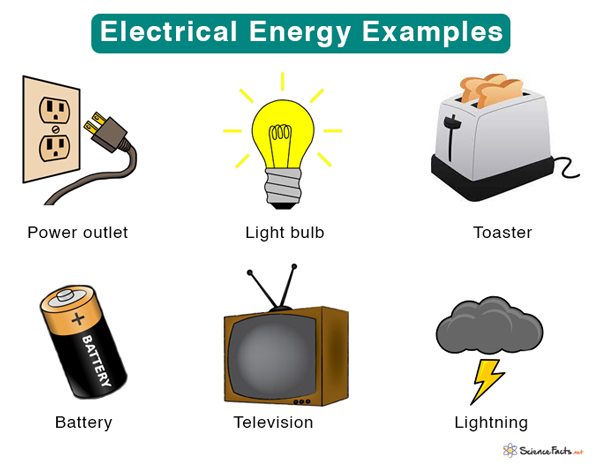
Electrical energy is the most suitable form of energy that people use in their daily life. It is caused by the flow of negatively-charged electrons in a conductor. The faster they move, the higher the energy generated. As the charge carriers are in motion, electrical energy is a form of kinetic energy. This flow of electrons through a conductor also produces an electric current resulting in electricity. Thus, electricity is an energy carrier to power homes and appliances.
Electrical energy can be stored in small quantities using fuel cells, batteries, capacitors, or magnetic fields. Charges build up in a capacitor, which then stores electrical energy. Thus, electrical energy is also a type of potential energy.

Electrical energy is not a primary source of energy. It is a secondary source because it is produced from primary energy sources such as coal, natural gas, nuclear energy, solar energy, and wind energy. These primary sources drive electric generators and solar cells to produce electricity for easy use and transport.
Electrical cables transport electricity from one place to another through conduction. Conductors made from metal are used for this purpose. This method of transporting electrical energy for hundreds of miles is called an electrical grid. The electrical grid’s rate of energy transfer is called electrical power.
The quantity of electrical energy transferred to an appliance depends on its power and the duration it is switched on. The amount transferred from the mains is measured in kilowatt-hours or kWh. It is the commercial unit of electricity. One unit is 1 kWh.
Equation
The equation for electrical energy is given by the following:
E : Energy transferred in kWh (1 kWh = 3.6 x 10 6 J)
P : Power of the appliance in kW (1 kW = 1000 W)
t : Amount of time in hours that the appliance operates ( 1 h = 3600 s)
Example: If a 60-Watt lamp is turned on for two hours, how many joules of electrical energy are converted?
Given P = 60 W, and t = 2 h = 2 x 3600 = 7200 s
Or, E = 60 Js -1 x 7200 s
Or, E = 432,000 J or 432 kJ

The law of conservation of energy states that energy cannot be created or destroyed. It is converted from one form into another. Below are some examples in which other forms of energy are converted into electrical energy.
1. Nuclear Power Plant
In a nuclear power plant, nuclear energy is converted into electrical energy. A fission reaction generates heat that converts water into steam. The steam rotates turbine blades that drive a generator to make electricity.
2. Hydroelectric Plant
In a hydroelectric plant, water falling from a certain height rotates a set of turbines. The turbines power the generators that are connected to them and create electrical energy.
3. Geothermal Power Plant
In a geothermal power plant, water present in reservoirs beneath Earth’s surface produces steam through natural means. The steam rotates a turbine that activates a generator, producing electricity.
4. Wind Turbine
An example of a machine that converts mechanical into electrical energy is a wind turbine. The blowing wind turns the turbine blades. The mechanical motion of the blades fires up an electric generator, creating electrical energy.
5. Solar Cells
Solar energy is produced directly from the sun. The sun’s rays strike solar cells or photovoltaic cells and generate a small electric voltage. By connecting large numbers of individual cells, a large amount of electricity can be generated in a solar electric plant.
6. Piezoelectricity
Kinetic energy can be converted to electrical energy through piezoelectricity. When sound energy, a form of kinetic energy, is applied to a piezoelectric material, it creates strain in the crystal and produces an electric current. The current is then harvested into electricity.
References